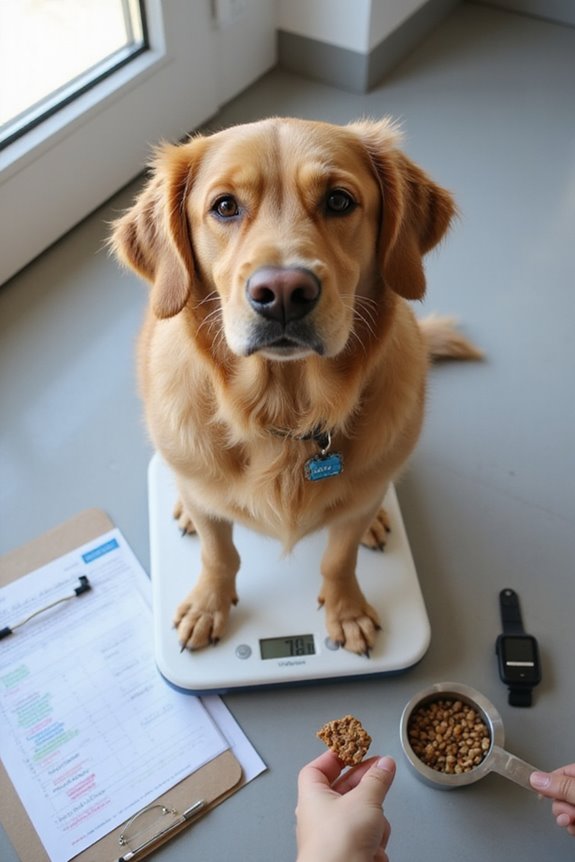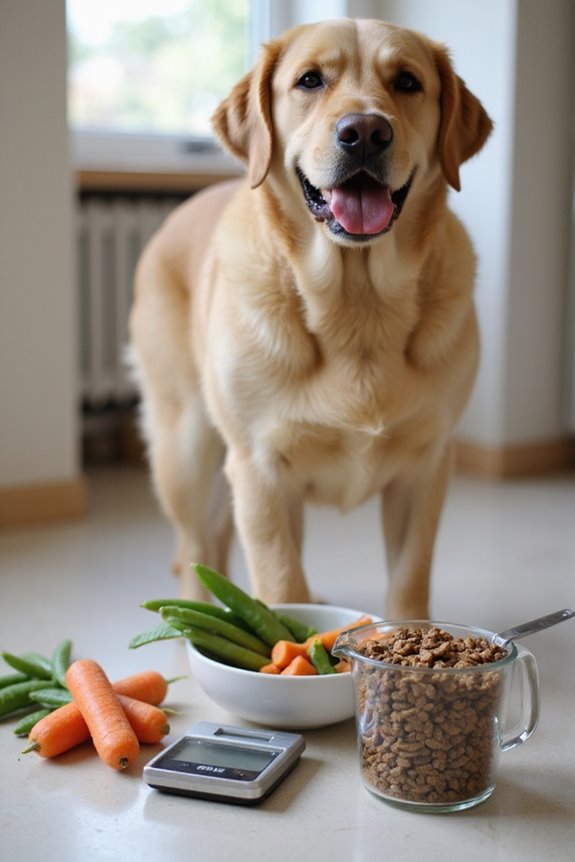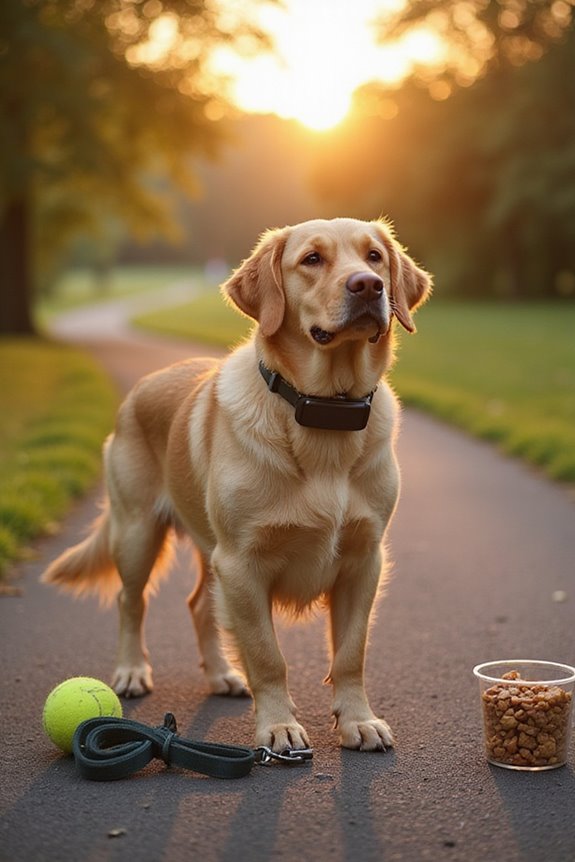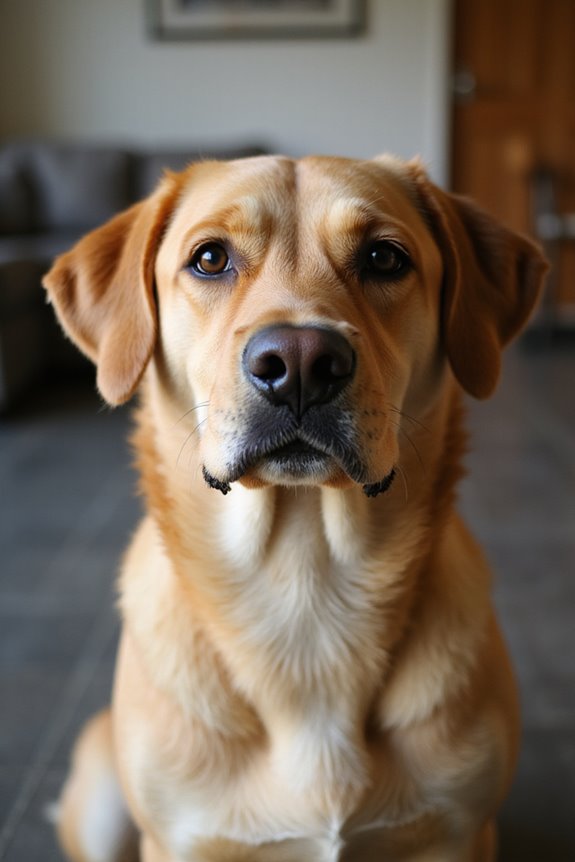To create a dog weight loss plan, start with a thorough veterinary assessment to identify health issues. Then, calculate your dog’s caloric needs using the Resting Energy Requirement formula. Focus on a balanced diet that includes high-quality protein, moderate fats, and increased fiber. Establish a structured exercise routine, like brisk walks, and monitor progress through regular weigh-ins and body condition scoring. Adjust the plan as needed to guarantee ongoing success and health improvements; further steps will guide you through this process.
Key Takeaways
- Conduct a thorough veterinary assessment to determine health status and identify obesity causes before starting a weight loss plan.
- Calculate your dog’s caloric needs using the RER formula and adjust for weight loss by setting MER equal to RER.
- Focus on a balanced diet with high-quality proteins, moderate fats, and increased fiber to promote satiety and maintain muscle mass.
- Establish a regular exercise routine that includes daily walks and engaging activities to enhance stamina and promote weight loss.
- Monitor progress with body condition scoring, regular weigh-ins, and a food and activity diary to ensure effective weight management.
Importance of Veterinary Assessment
When considering a weight loss plan for your dog, it is vital to start with a thorough veterinary assessment. This medical evaluation confirms your pet’s overall veterinary health and identifies any underlying issues contributing to obesity. Here’s what to expect:
- Baseline Measurements: Your vet will establish a body condition score and weight.
- Comprehensive Tests: Blood tests and urinalysis may be conducted to detect hormonal imbalances or metabolic diseases.
- Physical Examination: The vet may identify cardiovascular concerns that could complicate weight loss.
- Customized Recommendations: Dietary and exercise plans will be tailored to your dog’s breed, age, and health status.
Ultimately, this assessment is an important step in ensuring your dog’s safe and effective weight loss journey.
Calculating Caloric Needs

Calculating your dog’s caloric needs is vital for developing an effective weight loss plan, especially since each dog’s requirements can vary considerably based on several factors. To start, you can determine your dog’s Resting Energy Requirement (RER) using a simple caloric calculation method. First, convert your dog’s weight from pounds to kilograms by dividing by 2.2. Then, apply the energy requirement formula: RER = 70 × (BW in kg)^0.75.
Once you have the RER, calculate the Maintenance Energy Requirement (MER) by multiplying the RER with an appropriate activity factor. For weight loss, this means using an MER equal to RER. Adjust calorie intake as needed, monitoring progress to guarantee your dog’s health and wellness throughout the process.
Nutrition and Diet Composition

After understanding your dog’s caloric needs, the next step is to focus on nutrition and diet composition, which play a significant role in effective weight management. Achieving a proper nutrient balance is essential, so consider these key factors:
- Protein: Opt for high-quality sources to maintain muscle mass.
- Fat: Include moderate amounts to provide energy without excess calories.
- Carbohydrates: Use complex sources like brown rice and sweet potatoes for stability in energy levels.
- Fiber: Increase fiber content to promote satiety and digestive health.
Meal frequency is also important; feeding smaller portions multiple times a day helps manage hunger and regulate metabolism. Regularly assess your dog’s weight and adjust portions as needed to stay on track with weight loss goals. Additionally, consider incorporating joint-supporting ingredients into your dog’s diet to promote overall health during weight loss.
Establishing an Exercise Routine

Establishing an exercise routine is essential for supporting your dog’s weight loss journey, as regular physical activity not only aids in calorie burning but also enhances overall health. A daily brisk walk of at least 30 minutes is a great starting point; gradually increase duration and intensity to improve stamina.
To keep it engaging, mix in some fun activities like swimming, which is perfect for low-impact workouts, or short hikes that stimulate both body and mind. Aim for exercise variety with structured play sessions and interactive toys. Monitor your dog’s response to different activities to tailor the routine, ensuring it remains safe and enjoyable while promoting consistent weight loss. Always consult your veterinarian before introducing new exercises.
Monitoring Progress
Monitoring progress in a dog’s weight loss journey is essential for achieving successful outcomes. Regular body condition scoring (BCS) helps assess changes in fat cover and muscle mass, offering a more nuanced view than weight alone. Here’s how I track my dog’s progress:
- Weighing: I use the same digital scale consistently, aiming for biweekly vet visits if my dog is too large for home scales.
- Documentation: I maintain a detailed food and activity diary, which records caloric intake and exercise levels.
- Visual Records: Taking photos from various angles shows visual changes over time.
Incorporating these methods guarantees I stay accountable to my dog’s weight loss goals and can make informed adjustments with my vet’s guidance.
Behavioral Modifications
When it comes to helping your dog lose weight, implementing behavioral modifications is essential for long-term success. Effective behavior management starts with establishing a consistent feeding routine. Here are some practical strategies:
- Automatic Feeders: These reduce begging by helping your dog associate meals with the feeder, not you.
- Reward Systems: Use praise and play rather than food for good behavior.
- Small, Frequent Meals: Feeding smaller portions increases satiety and lowers begging.
- Non-Food Rewards: Replace high-calorie treats with low-calorie options or mental stimulation tools, like puzzle feeders.
- Environmental Controls: Remove access to trash or counters to prevent food-seeking behaviors. Additionally, incorporating interactive dog toys can further engage your dog’s mind and reduce the desire for excessive snacking.
Adjusting the Weight Loss Plan
Adjusting your dog’s weight loss plan is a critical component of ensuring their journey remains effective and sustainable. To manage portion control, I recommend using a kitchen scale for precise food measurements; this helps with gradual modifications based on monthly weight checks. Adopting a feeding schedule with smaller, more frequent meals can promote satiety and reduce begging behaviors.
When monitoring your dog’s progress, consider factoring in their activity level and health status. Gradual dietary adjustments over two to three weeks can prevent gastrointestinal distress. Remember to adjust meals thoughtfully, avoiding sudden changes. As your dog’s weight decreases, aim to increase their exercise intensity, ensuring a well-rounded approach to successful weight management. Additionally, incorporating high CFU probiotics can support your dog’s digestive health during their weight loss journey.
Frequently Asked Questions
How Can I Tell if My Dog Is Overweight?
You know, I often wonder about my dog’s health too. To assess their body condition, I check for a waist and feel their ribs during a weight assessment. Subtle signs can reveal their wellbeing, don’t you think?
What Are Common Health Risks Associated With Dog Obesity?
I’ve learned that dog obesity brings serious health complications, like diabetes and joint pain. That’s why I always take preventative measures, ensuring my pup stays active and eats right for a happier, longer life.
Can Certain Breeds Lose Weight More Easily Than Others?
When it comes to weight loss, I’ve noticed that some breeds, with their unique metabolism and exercise requirements, seem to shed pounds easier than others. It’s fascinating how each breed approaches this challenge differently, isn’t it?
How Often Should I Consult My Veterinarian During the Weight Loss Plan?
I find it’s important to schedule veterinary check-ups every two to four weeks during my dog’s weight monitoring. This way, we can track progress together and make any necessary adjustments for a healthier, happier pup.
What Timeline Can I Expect for Noticeable Weight Loss in My Dog?
You can expect noticeable weight loss in your dog within six to eight months. I recommend consistent progress tracking every two weeks; it keeps us motivated and helps adjust the plan for the best results.




